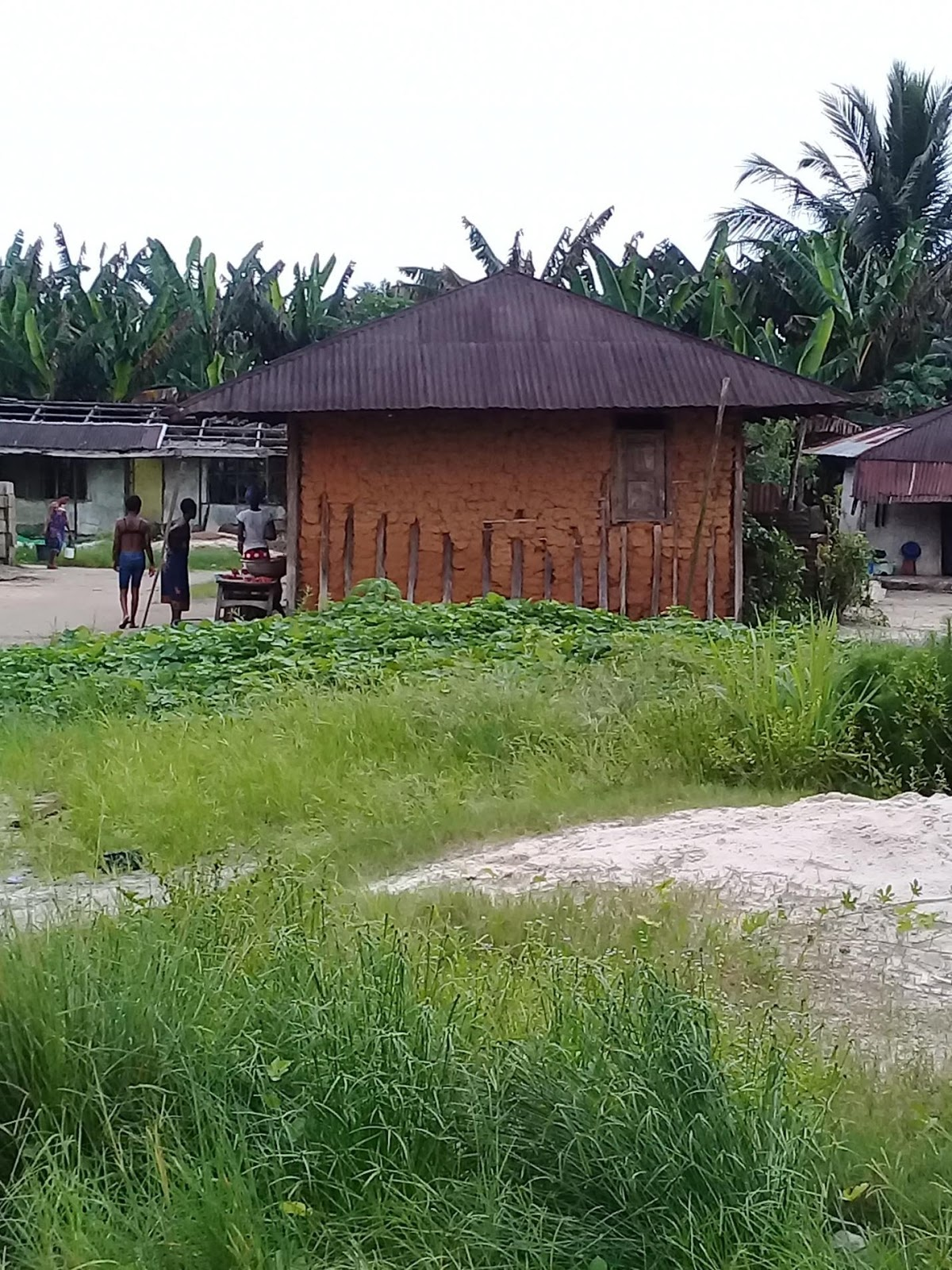Title of the work
Country of the First Edition
Country/countries of popularity
Original Language
Registration Files

Fig. 1 Photograph of a typical village house at Emede taken by the researcher, Franca Okumo.
Country of the Recording of the Story for the Database
Full Date of the Recording of the Story for the Databasey
More Details of the Recording of the Story for the Database
Genre
Myths
Target Audience
Crossover (young adults, adults)
Cover

We are still trying to obtain permission for posting the original cover.
Author of the Entry:
Divine Che Neba, University of Yaoundé 1,nebankiwang@yahoo.com
Franca Okumo, Federal University Otuoke, Bayelsa State, Nigeria, fokumo@yahoo.com
Peer-reviewer of the Entry:
Daniel A. Nkemleke, University of Yaoundé 1, nkemlekedan@yahoo.com
Elżbieta Olechowska, University of Warsaw, elzbieta.olechowska@gmail.com

Benjamin Emeada (Storyteller)
Age of narrator: 79 (in 2018)
Social status: An elder in the community
Profession: Retired school teacher
Language of narration: English
Bio prepared by Eleanor A. Dasi, University of Yaoundé 1, wandasi5@yahoo.com and Franca Okumo, Federal University Otuoke, fokumo@yahoo.com and Divine Che Neba, University of Yaoundé 1, nebankiwang@yahoo.com
Origin/Cultural Background/Dating
Cultural Background: The Isoko people are found in the South East of Delta State in Nigeria. They are one of the minority ethnic groups in the Niger Delta region. They have two local government areas, Isoko North with the headquarters in Ozoro and Isoko South with the headquarters in Oleh. They are made up of nineteen clans. They are a peaceful people whose major occupation is farming, fishing and trading. They are believed to have originated from Benin. The Isoko people are mostly idol worshipers. They believe in the supreme creator and in ancestral spirits which are seen as god’s messengers. They do not only consult diviners to foretell their future but also to fortify themselves against any contrary force. However, majority of them are now nominal Christians by virtue of the spread of Christianity.
Summary
The Owhe people (Otor-Owhe, Owhelogbo and Akiewhe) celebrate the feast of OYISE OWHE. It is believed that Azagba migrated to Emede due to oppression and dispossession in his hometown. He got married to Owhe of Emede. The union produced three sons: “Ovoh” who founded Otor-Owhe, Ogbe who founded Owhelogbo and Uthatho who founded Akiewhe. A myth has it that, Ithatho, the daughter of Uthatho who was married to Uruafe, saw the feather of an eagle falling from the sky in their farm. To her greatest amazement, the eagle’s feather stood erect on the ground spinning round and round. The spinning was rapid to the extent that one could believe that there was life in it. Seeing this marvel, she ran home to inform her husband, who later went to the farm and took the feather home.
While still wondering about the event of the feather, there was a sudden appearance of the goddess, Oyise. She told them that she was directed by Oni-Oyise to shield Owhe, a descendant of Emede from danger and to grant her divine favour. To clarify this claim, they consulted an oracle that confirmed the claims of the goddess to be true. In line with the instruction given by the goddess, a shrine was erected and in the shrine, three images were erected, representing the founder of the clan, his wife and their head servant. A sculpture of a woman carrying a child in the arms was also molded. Some other objects associated with the shrine are the Ivri and three ancestral boxes.
Following the wide acceptance of the week long Oyise-Owhe festival, preparations are usually made to enhance the success of the event. The festival is celebrated once every three years. It is believed that at about the festival period, the goddess usually appears to the people of the Owhe clan in different forms. The goddess symbolizes unity, peace and progress to the Owhe people.
Analysis
From time immemorial, in most societies, the inexplicable has usually been associated with witchcraft. Such belief had taken deeper roots in Africa, most especially where some birds and animals have always been viewed as omens. The appearances of certain animals and birds including bats, owls, hawks, eagles; their postures in the sky and on earth; their chirps during the day and night have often been a cause for concern in the cosmic order of different communities around the world. These birds have brought joy to some families and misery to others. As seen in the above myth, the appearance of the spinning feather traumatized Ithato before her husband’s intervention. Similarly, many families have celebrated or suffered similar fates as the chirp of each of these birds is symbolic. Among the Owhe people of Nigeria, the eagle is a symbol of hope, aspiration, protection and blessing. The appearance of its feather first, on the land, and second, in the household of Emede, prefigures blessing and protection from the goddess, Oyise, to the people of Owhe who erected a shrine in honor of the clan on the spot where the spinning eagle feather was found.
Simply put, birds are believed to be forecasters and symbols not only in Africa but in the world at large.
Further Reading
Arnott, Bruce, African Folklore: The mystery of Birds Part 2, blog.londolozi.com, September 16, 2017 (accessed: June 3, 2019).
Addenda
Researcher: Franca Okumo
Method of data collection: Note taking


